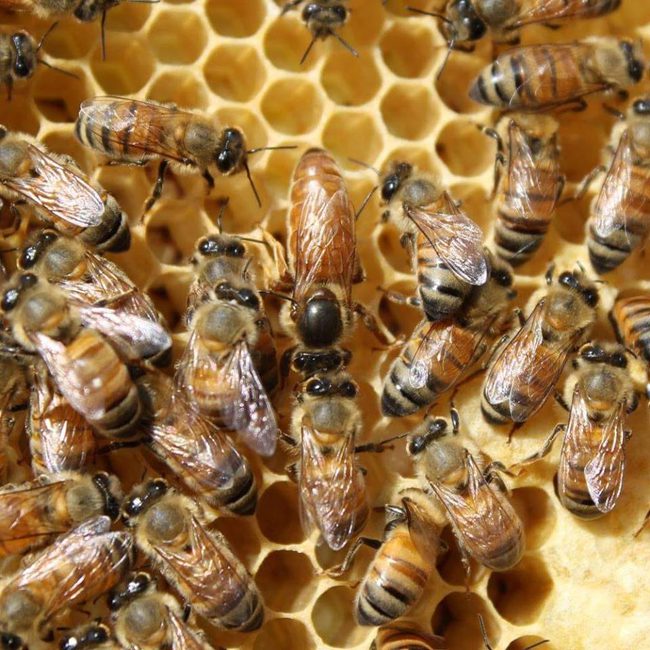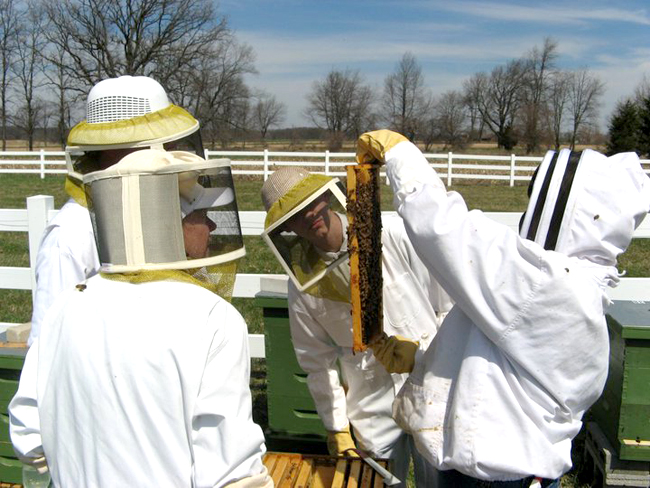
Bob Jastrzebski has two bee hives hidden in the trees of his home in a Canton Township subdivision.
At one point, he had a neighbor who suddenly saw improvement in his tomato plants. Both men attributed the rise in the neighbor’s tomato production to the presence of the two hives.

“He told me ‘ever since you put those hives up, I’m getting more tomatoes,’” Jastrzebski said. “Without the bees, maybe only one plant gets pollinated. That’s a big difference for gardens.”
That small-scale success Jastrzebski, owner of BobilinHoney (www.bobilinhoney.com), had with those hives illustrates the importance bees play in growing crops of all kinds. That’s also the subject of a U.S. Geological Survey study that says “critical honey bee and wild bee populations in the United States have been declining in recent years, creating concern about the future security of pollination services for agricultural crops.”
Bees are critical to pollination of many crops, including blueberries, apples, pears, pumpkins and cherries. [Editor’s note: read our story from 2008 to see what we learned then about bees and crops. https://www.corpmagazine.com/features/cover-stories/the-bzzz-ness-of-michigan-bees/]
Discovering what bees like to eat has important ramifications for growers and farmers whose apples, cherries, blueberries, squash, cucumbers, pumpkins, pears and other flowering fruits and vegetables depend on bees for pollination, said Logan Rowe, a co-author of a recently published study examining Michigan bees’ feeding preferences.
The research can help farmers and growers decide what native plants to grow near their orchards and fields, said Rowe, a zoologist with Michigan State University Extension and the Michigan Natural Features Inventory.

The study said, “Since bees obtain nearly all their nutritional requirements from pollen and nectar provided by flowering plants, the availability of these resources within bees’ flight range is crucial to their survival. Flower plantings have been shown to increase the yield of adjacent pollinator-dependent crops.”
Rowe said, “We already encourage growers to incorporate native plants,” and the findings will help them more accurately select the best seed mixtures to attract bees.
The plants used to attract the bees are important, according to Jastrzebski, who said primary crops like corn, wheat and soy beans aren’t that attractive to bees. He also said popular bee plants are being taken down in favor of other crops.
“Hedge rows and ditches and places where a lot of natural flowers bloom are being taken away,” Jastrzebski said. “The natural pollen sources are gone, and farmers are spraying fungicides and other (chemicals). When you’re taking habitat away … the farmer is farming every inch of the field. There’s nothing left for the bees to have. Even bees in the wild … you don’t have as many.”
According to the study, reasons for the decline include pests, pesticides, colony collapse disorder and diseases, as well as “shifting landscapes” in the Midwest where cropland is expanding at the expense of “crucial native grasslands and conservation lands that have historically provided abundant flowers for honey bees and native pollinators,” the Geological Survey said.
Scientists conducted the Michigan study in the Northwest Michigan Horticultural Research Center in Leelanau County, the Clarksville Research Center in Ionia County and the Southwest Michigan Research and Extension Center in Berrien County.
They planted 51 species of drought-tolerant native prairie plants and two non-native species, then observed more than 3,500 honey bees, wild bees and bumblebees as they visited the flowers.
“We were seeing which were most supportive of pollinators,” Rowe said. There’s been little prior research about what types of flowering plants in Michigan’s prairie-type habitat appeal best to different types of bees.
One surprise finding is that bees in different regions of the state have different dietary preferences, he said.
Bees aren’t the only beneficiaries of targeted plantings, the study said. They also provide habitat for threatened wildlife.
The study by researchers at MSU and the University of Manitoba appeared in the journal “Environmental Entomology.”
Eric Freedman, Capital News Service, contributed to this report. Read the original CNS Story at
http://news.jrn.msu.edu/2019/02/culinary-guide-gives-bees-something-to-buzz-about






